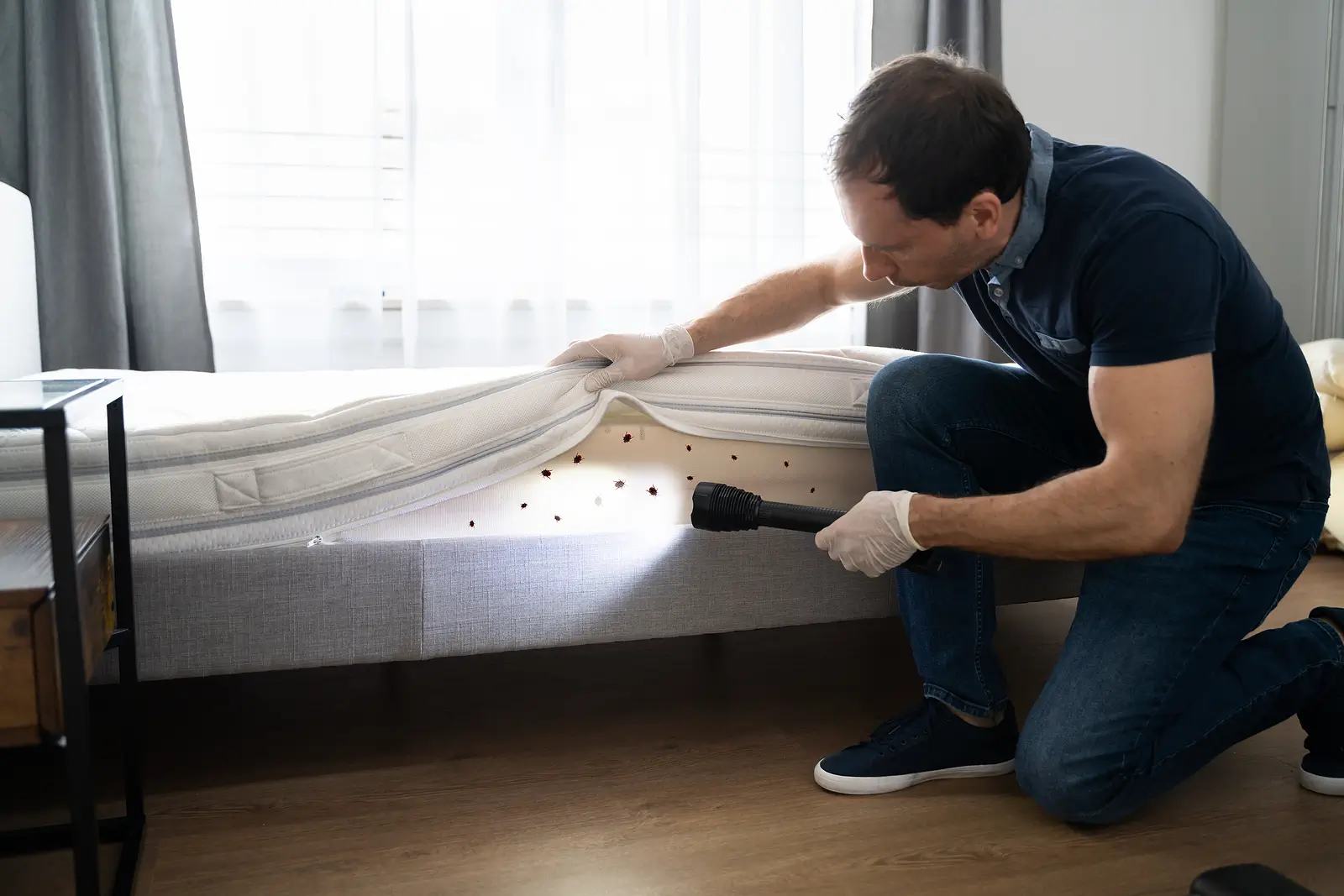A bed bug infestation can turn even the best-managed rental property into a nightmare. These tiny reddish-brown insects thrive in bed frames, box springs, upholstered furniture, and even electrical outlets, making them one of the toughest common pests to deal with.
While they don’t transmit diseases, they feed on human blood at night and often cause allergic reactions, sleepless nights, and significant stress for tenants.
As a landlord, your responsibility is not only to protect your investment but also to protect tenants by keeping your property habitable. Whether you own single-family rentals or manage multi-unit buildings or apartment buildings, you need to know how to prevent, detect, and respond to bed bug issues.
Key Takeaways:
- Detect early signs of bed bugs to reduce extermination costs and protect your property.
- Landlords and tenants share responsibilities in reporting and treating bed bugs effectively.
- Partnering with a pest management professional is the best way to eliminate infestations and prevent future outbreaks.
Understanding Bed Bugs: Why They’re Different From Other Common Pests
Unlike many common pests, bed bugs survive solely on human blood. These flat, reddish brown insects usually emerge at night and return to their hiding spots during the day. They are often found in box springs, bed frames, and upholstered furniture, but can also live in walls, electrical outlets, and cracks in floors.
Bed bugs are hardy. They can live up to a year without feeding and reproduce rapidly, which makes them one of the most challenging infestations to manage in a rental property. For landlords with apartment buildings or multi-unit buildings, a single bed bug problem in one rental unit can easily spread to adjacent units and affect other tenants.
Landlord Responsibility: Respond Quickly and Proactively
When it comes to bed bug issues, ignoring tenant complaints is the fastest way to turn a small situation into a full-scale crisis. In most areas, state laws hold landlords responsible for ensuring a habitable property, and that includes bed bug control.
Both the landlord and the tenant have roles:
- Tenant responsibilities include reporting bed bug sightings early, preparing their unit for treatment, and avoiding second-hand furniture that may carry pests.
- Landlords must respond quickly, schedule a professional bed bug inspection, and work with a pest management professional to arrange treatment.
Tenant education also matters. Teaching residents to recognize early signs, such as fecal spots, shed skins, or tiny bugs near bedding, can help limit infestations and reduce extermination costs.
Bed Bug Prevention: Smart Steps That Save Money
Bed bug prevention should always be part of a landlord’s long-term management strategy. Preventing infestations is far less costly than arranging multiple treatments after an outbreak.
Ways to prevent bed bugs in your rentals:
- Regular inspections of units, especially during turnover.
- Install protective covers, such as mattress and box spring encasements, to remove hiding spots.
- Encourage tenants to report bed bug infestations or signs of bugs immediately.
- Share resources on how to identify bed bugs and avoid bringing them in through second-hand furniture.
With these proactive measures, landlords can avert widespread infestations across many tenants in large buildings.
Bed Bug Extermination: What Works and What Doesn’t
When prevention fails, treating bed bugs requires professional help. Relying on quick DIY fixes like bug bombs or talcum powder doesn’t work. In fact, they often make infestations worse by scattering pests into new areas.
Effective treatment methods include:
- High heat treatments – A clothes dryer on high heat kills bed bugs and their eggs.
- Steam treatments – Direct steam destroys bugs hiding in fabrics and cracks.
- Insecticides – Safe and effective when applied by a licensed pest management professional following label directions.
- Diatomaceous earth – A natural product that helps with bed bug control when combined with other methods.
The whole process can take weeks and may require follow-up visits, especially in bed bug-infested units within multi-unit buildings.
Getting Rid of Bed Bugs: The Whole Process
To completely eliminate bed bugs, landlords must take a systematic approach:
- Wash all clothing, bedding, and personal items in hot water and dry on high heat.
- Vacuum regularly around bed frames, box springs, upholstered furniture, and baseboards.
- Seal cracks, gaps, and electrical outlets to block hiding spots.
- Dispose of heavily infested items responsibly to avoid spreading pests to other tenants.
For larger properties, coordinate with property managers and tenants to ensure the treatment of infestations in all affected rental units. If you only treat one space, pests will migrate back.
Bed Bug Control: Keeping Rentals Protected
Long-term bed bug control is about consistency. Here’s how landlords can keep their properties protected:
- Schedule regular inspections with trusted pest management professionals.
- Provide ongoing tenant education about early signs and reporting bed bug infestations.
- Use preventative products like protective covers to reduce hiding places.
- Partner with property managers to ensure pest control is part of your rental strategy.
With these strategies, landlords can protect their property, maintain tenant trust, and avoid recurring bed bug problems.
Safeguard Your Property and Tenants
Bed bug infestations are one of the most frustrating challenges in rental management, but with proactive measures, quick response, and professional support, they can be handled effectively. The goal is to protect tenants, reduce extermination costs, and keep your rentals pest-free.
Round Table PM is here to help landlords do just that. Whether you’re dealing with bed bug issues, other common pests, or the daily responsibilities of managing a rental property, our team provides expert solutions.
Explore our services or contact us today to see how we can support your success.
Frequently Asked Questions
Q1: How can landlords identify early signs of bed bugs?
Check for reddish brown insects, tiny blood spots on sheets, or dark fecal stains around beds. A bed bug inspection can confirm suspicions.
Q2: Are tenants responsible for bed bug infestations?
Both the landlord and the tenant share responsibility. Tenants should report bed bug infestations promptly, while landlords are required to arrange treatment under most state laws.
Q3: Can bed bugs spread in apartment buildings?
Yes, bed bugs can move between adjacent units through cracks, vents, or electrical outlets, affecting other tenants. Coordinated treatment is essential.
Q4: Do bug bombs kill bed bugs?
No. Bug bombs are ineffective because they don’t reach deep hiding places like box springs and cracks. Professional methods are required to kill bed bugs.
Q5: What’s the safest and most effective way to treat infestations?
Hiring a pest management professional who uses a mix of high heat, steam, and pesticides according to label directions is the most reliable approach.






